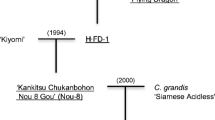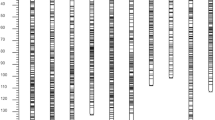Abstract
Citrus chlorotic dwarf disease (CCDD) has been associated with loss of productivity in citrus species. Especially in the grapefruit species this loss can reach up to 50%. The causative agent for the disease is Citrus chlorotic dwarf associated virus. Some species in the citrus family can develop resistance to the virus and overcome the symptoms associated with the disease but in those cases they may act as the source of the virus to the surrounding citrus species. Virus management studies mainly focus on the introgression of available virus resistance genes into valuable plant cultivars. In this study, we focused host based aspect of the resistance against the virus. Clementine mandarin × Minneola tangelo hybrid population was created in the Alata Horticultural Research Institute field in 2008. This population showed a resistance to the disease development and we analyzed 186 individuals with a total of 2806 markers. DArT-SNP markers were utilized for the mapping studies. According to our results 9 linkage groups were obtained for Clementine and Minneola. The total length of these groups was 798.70 cm for Clementine and 423.7 cm for Minneola. The total number of markers in the linkage groups was 1536 for Clementine and 1270 for Minneola. The average distance between two markers was 0.51 cm and 0.33 cm for Clementine and Minneola, respectively. 15 QTL loci (with LOD ≥ 3) were associated with CCDD resistance. All of these QTLs’ were specifically determined in Clementine linkage map on LG2, LG3, LG5, LG6 and LG8. Host based genetic characteristics that enable the resistance to the disease were identified by QTL based analysis. These results can pave the way of genetic screening of the resistant versus vulnerable species as well as individuals within the species. Moreover, based on this data genetic manipulations or hybridizations based on the genetic markers can be considered in the future to increase the productivity and to decrease the losses associated with CCDD.




Similar content being viewed by others
Availability of data and materials
All the data is presented in the supplementary information folder but the data is available upon reasonable request.
References
Çınar A, Kersting U, Önelge N, Korkmaz S (1993) Citrus virus and virus-like diseases in the Eastern Mediterranean region of Turkey. In: Proceeding of the Conference IOCV, 12:377–400
Çınar A, Korkmaz S, Önelge N, Kersting U (1994) Doğu Akdeniz Bölgesinde Virus ve Virüs-Benzeri Hastalıkların Durumu. Ç ü Zir Fak Der 9(4):151–158
Dominguez-Garcia MC, Belaj A, de la Rosa R, Satovic Z, Heller-Uszynska K, Kilian A, Martin A, Atienza SG (2012) Development of DArT markers in olive (Olea europaea L.) and usefulness in variability studies and genome mapping. Sci Horticu 136:50–60
Doyle JJ, Doyle JL (1990) Isolation of plant DNA from fresh tissue. Focus 12:13–15
Jaccoud D, Peng KM, Feinstein D, Kilian A (2001) Diversity Arrays: a solid state technology for sequence information independent genotyping. Nucleic Acids Res 29(4):e25
Jarell DC, Roose ML, Traugh SN, Kupper RS (1992) A genetic map of citrus based on the segregation of isozymes and RFLPs in an intergeneric cross. Theor Appl Genet 84:49–56
Karanfil A (2019) Turunçgil klorotik cüceleşme ile ilişkili virüs (citrus chlorotic dwarf associated virus; ccdav)’ün etiolojisi ve moleküler karakterizasyonu. Doktora Tezi. Çanakkale Onsekiz Mart Üniversitesi, Çanakkale
Karanfil A, Korkmaz S (2018) Genetic diversity of Turkish citrus chlorotic dwarf-associated virus isolates based on coat protein gene. Fresenius Environ Bull 27(9):6403–6407
Karanfil A, Korkmaz S (2019) Geographic distribution and molecular characterization of Turkish isolates of the citrus chlorotic dwarf-associated virus. J Plant Pathol 101:621–628
Kersting U, Korkmaz S, Ertuğrul B, Önelge N, Garnsey SM (1996) Citrus chlorotic dwarf, a new whitefly-transmitted disease in the eastern Mediterranean region of Turkey. In: Proceedings of the 13th Conference of the International Organization of Citrus Virologists. IOCV, Riverside, California, pp 220–225
Korkmaz S (1997) Detection of vector-transmitted virus-like disease in citrus in the East Mediterranean Region: Studies on spread, transmission and evaluation of sensitive varieties and species.
Korkmaz S (2000a) Doğu Akdeniz Bölgesi Turunçgil Ağaçlarında Vektörle Taşınan Turunçgil Klorotik Cüceleşme Hastalık Etmeninin Tanısı Üzerine Araştırmalar. Ç. Ü. Zir. Fak. Der., 15
Korkmaz S (2000b) Studies on spread and characterization of the Citrus Chlorotic Dwarf agent in the Eastern Mediterranean region of Turkey. J Turk Phytopathol 29(2–3):113–119
Korkmaz S, Cinar A, Bozan O, Kersting U (1994a) Distribution and natural transmission of a new whitefly-borne virus disease of citrus in the eastern Mediterranean region of Turkey. In: Proc 9th Congress Mediterranean Phytopathological Un 437–439
Korkmaz S, Cinar A, Demirer E, O ̈nelge N (1994b) Greenhouse observation onthe susceptibility of 36 citrus varieties to a new whitefly-borne virus. In: Proc 9th Congress Mediterranean Phytopathological Un 305–306
Korkmaz S, Cinar A, Kersting U, Garnsey SM (1995) Citrus chlorotic dwarf: a new whitefly-transmitted viruslike disease of citrus in Turkey. Plant Dis 79(10):1074
Korkmaz S, Kersting U, Ertuğrul B, Çınar A (1996) Transmission and epidemiology of citrus chlorotic (CCD) disease in the Eastern Mediterranean Region of Türkiye. J Turk Phytopath 25(1–2):71–76
Loconsole G, Saldarelli P, Doddapaneni H, Savino V, Giovanni PM (2012) Identification of a single-stranded DNA virus associated with citrus chlorotic dwarf disease, a new member in the family Geminiviridae. Virology 432:162–172
Nadeem MA, Nawaz MA, Shahid MQ, Doğan Y, Comertpay G, Yıldız M, Hatipoğlu R, Ahmad F, Alsaleh A, Labhane N, Özkan H, Chung G, Baloch FS (2018) DNA molecular markers in plant breeding: current status and recent advancements in genomic selection and genome editing. Biotechnol Biotechnol Equip 32(2):261–285
Van Ooijen JW (2009) MapQTL 6, software for the mapping of quantitative trait loci in experimental populations of diploid species. Kyazma BV, Wageningen, the Netherlands
Acknowledgements
This study was supported by Ministry of Agriculture and Forestry, General Directorate of Agricultural Research and Policies of Turkey (TAGEM). We greatly appreciate their support.
Funding
This study was supported by Ministry of Agriculture and Forestry, General Directorate of Agricultural Research and Policies of Turkey (TAGEM). We greatly appreciate their support.
Author information
Authors and Affiliations
Contributions
All the authors contributed to the conceptualization, writing and revision of the manuscript. DA was responsible for the data collection and together with the rest of the authors she analyzed the data.
Corresponding authors
Ethics declarations
Conflict of interests
None of the authors have either financial or non-financial conflict of interest to declare.
Consent for publication
Not applicable.
Ethics approval and consent to participate
Not applicable.
Additional information
Publisher's Note
Springer Nature remains neutral with regard to jurisdictional claims in published maps and institutional affiliations.
Rights and permissions
Springer Nature or its licensor (e.g. a society or other partner) holds exclusive rights to this article under a publishing agreement with the author(s) or other rightsholder(s); author self-archiving of the accepted manuscript version of this article is solely governed by the terms of such publishing agreement and applicable law.
About this article
Cite this article
Aksoy, D., Yeşiloğlu, T., Serçe, Ç.U. et al. Determination of genomic regions related citrus chlorotic dwarf disease in clementine mandarin × Minneola tangelo hybrid population by QTL analysis. Euphytica 219, 24 (2023). https://doi.org/10.1007/s10681-023-03154-9
Received:
Accepted:
Published:
DOI: https://doi.org/10.1007/s10681-023-03154-9




